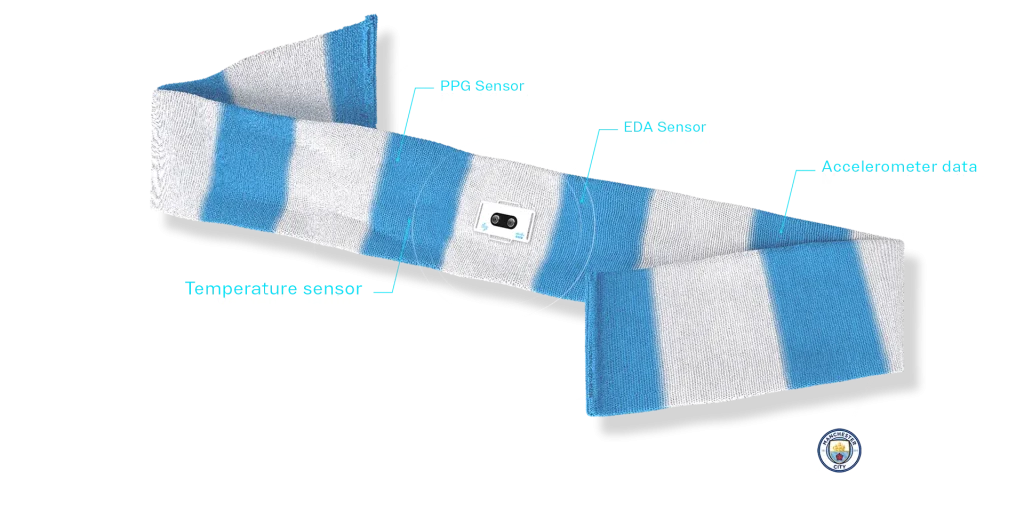Member Insights: Will we ever reach the tipping point with technology in sport?
August 8, 2022
With wearables, NFTs and virtual stadiums in the offing, David Granger wonders if there is a danger we will overdose on innovation and lose fan loyalty by introducing too many shiny new things in sport?
Is there – or should there be – a limit to the technology which wraps around sport? While Hawkeye in tennis, VAR in football and the snickometer in cricket (arguably) make better, objective decisions in ensuring we’re all playing by the rules, do we get to a stage when we say… enough is enough?
The question was raised when Manchester City unveiled their connected scarf powered by Cisco https://www.mancity.com/club/partners/cisco/the-connected-scarf. It’s your average blue and white City stripes to the uninformed, but inside there’s enough tech to monitor fans’ heart rate, nervous system, movement, gestures and temperature. Clever stuff and an interesting use of technology and data… but to what end? This is where the wearable needs a little more explanation.
“If this sounds all a bit more 1984 and less 4-4-2, then perhaps sport needs to be aware of ensuring what can be doesn’t trump what should be done to enhance the fans’ engagement and deepen their loyalty.”
Well… Ashley Marusak, Cisco’s global sports marketing manager, told Reuters: “We seek to better understand and measure the ups and downs of football fandom and how the game impacts supporters not only emotionally, but physically as well.”
But how would you measure these things, who will use the data collected and, er… why? Various forums have suggested it could help direct sponsors and advertisers during a moment of need. If the fan in question is dehydrated a drinks company could swoop in to offer refreshment, the emotional reactions could trigger a certain advertiser to appear in front of them. If this sounds all a bit more 1984 and less 4-4-2 (or a Pep Guardiola 4-3-3), then perhaps sport needs to be aware of ensuring what can be done doesn’t trump what should be done to enhance the fans’ engagement and deepen their loyalty.
City’s Premier League rivals Liverpool dipped more than a toe into the waters of new technology with their LFC Heroes Club launch. The idea was to create a “fun and innovative way to celebrate being an LFC fan”. This fun and innovation came via an opportunity to buy one of 171,072 NFTs* starting at US$75.
Intended to boost the club’s charitable foundation coffers as well as raise funds, it wasn’t a major success. The club defended the launch https://coinmarketcap.com/alexandria/article/liverpool-fc-defends-nft-collection-after-criticism-and-vows-not-to-release-fan-tokens by saying it wanted to connect with all fans, across the global to ensure they were reaching a worldwide audience. Perhaps digital art ownership was not the way. There was a backlash from fans and only 9,721 of those 171 thousand NFTs were sold.
While LFC Heroes Club did earn Liverpool $1,472,565 ($1,027,193 after charitable contributions), this figure was way short of the anticipated $11.2 million.
And while what were once private spats (we may be looking in the direction of the premature and unfortunate Alpine F1 line-up announcement which the driver in question immediately refuted on Twitter: https://twitter.com/OscarPiastri/status/1554527452231262210 are now broadcast on social for the world to follow, one former world champion decided his retirement would be a good time to join Instagram.
Four-time F1 world champion Sebastian Vettel has been notoriously averse to social media. When at Red Bull Racing he once asked the then digital manager why people were bothering reading the team’s social channels. His rationale was that they “should go out and do something.”
He subsequently stated he’d only go on social when he retired from racing. And so when he created an Instagram account at the end of July, it was indeed to announce his retirement https://www.instagram.com/p/CgjUE5xKW-B/ But fair play to him. To date there are two posts and a following of more than two million. Most social managers would chew their own arm off to match his average engagement rate.
Vettel is an example of choosing the right technology at the right time. Sport and technology have always been close bedfellows and for every overreach, there will be an early adapter who sees potential in new technology in sport to enhance the game and the business. Will this be Manchester City’s plan to build a football stadium in the https://coinmarketcap.com/alexandria/article/man-city-building-football-stadium-in-the-metaverse metaverse..? we’ll have to wait and virtually see.
*Non-fungible tokens are unique digital assets. Information about them is stored on Blockchain, making it easy to prove who owns an NFT owns an artwork associated with the NFT in question.


